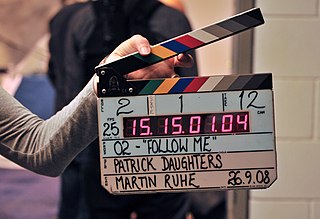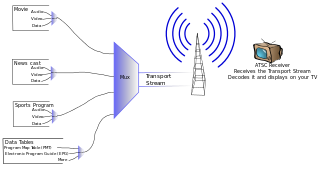Related Research Articles

Analog television is the original television technology that uses analog signals to transmit video and audio. In an analog television broadcast, the brightness, colors and sound are represented by amplitude, phase and frequency of an analog signal.

MPEG-2 is a standard for "the generic coding of moving pictures and associated audio information". It describes a combination of lossy video compression and lossy audio data compression methods, which permit storage and transmission of movies using currently available storage media and transmission bandwidth. While MPEG-2 is not as efficient as newer standards such as H.264/AVC and H.265/HEVC, backwards compatibility with existing hardware and software means it is still widely used, for example in over-the-air digital television broadcasting and in the DVD-Video standard.

NTSC is the first American standard for analog television, published in 1941. In 1961, it was assigned the designation System M. It is also known as EIA standard 170.

Closed captioning (CC) and subtitling are both processes of displaying text on a television, video screen, or other visual display to provide additional or interpretive information. Both are typically used as a transcription of the audio portion of a program as it occurs, sometimes including descriptions of non-speech elements. Other uses have included providing a textual alternative language translation of a presentation's primary audio language that is usually burned-in to the video and unselectable.
A timecode is a sequence of numeric codes generated at regular intervals by a timing synchronization system. Timecode is used in video production, show control and other applications which require temporal coordination or logging of recording or actions.

SMPTE timecode is a set of cooperating standards to label individual frames of video or film with a timecode. The system is defined by the Society of Motion Picture and Television Engineers in the SMPTE 12M specification. SMPTE revised the standard in 2008, turning it into a two-part document: SMPTE 12M-1 and SMPTE 12M-2, including new explanations and clarifications.

Component video is an analog video signal that has been split into two or more component channels. In popular use, it refers to a type of component analog video (CAV) information that is transmitted or stored as three separate signals. Component video can be contrasted with composite video in which all the video information is combined into a single signal that is used in analog television. Like composite, component cables do not carry audio and are often paired with audio cables.

Serial digital interface (SDI) is a family of digital video interfaces first standardized by SMPTE in 1989. For example, ITU-R BT.656 and SMPTE 259M define digital video interfaces used for broadcast-grade video. A related standard, known as high-definition serial digital interface (HD-SDI), is standardized in SMPTE 292M; this provides a nominal data rate of 1.485 Gbit/s.

Lip sync or lip synch, short for lip synchronization, is a technical term for matching a speaking or singing person's lip movements with sung or spoken vocals.
MPEG transport stream or simply transport stream (TS) is a standard digital container format for transmission and storage of audio, video, and Program and System Information Protocol (PSIP) data. It is used in broadcast systems such as DVB, ATSC and IPTV.
The Precision Time Protocol (PTP) is a protocol used to synchronize clocks throughout a computer network. On a local area network, it achieves clock accuracy in the sub-microsecond range, making it suitable for measurement and control systems. PTP is employed to synchronize financial transactions, mobile phone tower transmissions, sub-sea acoustic arrays, and networks that require precise timing but lack access to satellite navigation signals.

Asynchronous Serial Interface, or ASI, is a method of carrying an MPEG Transport Stream (MPEG-TS) over 75-ohm copper coaxial cable or optical fiber. It is popular in the television industry as a means of transporting broadcast programs from the studio to the final transmission equipment before it reaches viewers sitting at home.

An ATSCtuner, often called an ATSC receiver or HDTV tuner, is a type of television tuner that allows reception of digital television (DTV) television channels that use ATSC standards, as transmitted by television stations in North America, parts of Central America, and South Korea. Such tuners are usually integrated into a television set, VCR, digital video recorder (DVR), or set-top box which provides audio/video output connectors of various types.
A video signal generator is a type of signal generator which outputs predetermined video and/or television oscillation waveforms, and other signals used in the synchronization of television devices and to stimulate faults in, or aid in parametric measurements of, television and video systems. There are several different types of video signal generators in widespread use. Regardless of the specific type, the output of a video generator will generally contain synchronization signals appropriate for television, including horizontal and vertical sync pulses or sync words. Generators of composite video signals will also include a colorburst signal as part of the output.
Latency refers to a short period of delay between when an audio signal enters a system and when it emerges. Potential contributors to latency in an audio system include analog-to-digital conversion, buffering, digital signal processing, transmission time, digital-to-analog conversion and the speed of sound in the transmission medium.
An audio synchronizer is a variable audio delay used to correct or maintain audio-video sync or timing also known as lip sync error. See for example the specification for audio to video timing given in ATSC Document IS-191. Modern television systems use large amounts of video signal processing such as MPEG preprocessing, encoding and decoding, video synchronization and resolution conversion in pixelated displays. This video processing can cause delays in the video signal ranging from a few microseconds to tens of seconds. If the television program is displayed to the viewer with this video delay the audio-video synchronization is wrong, and the video will appear to the viewer after the sound is heard. This effect is commonly referred to as A/V sync or lip sync error and can cause serious problems related to the viewer's enjoyment of the program.
Display lag is a phenomenon associated with most types of liquid crystal displays (LCDs) like smartphones and computers and nearly all types of high-definition televisions (HDTVs). It refers to latency, or lag between when the signal is sent to the display and when the display starts to show that signal. This lag time has been measured as high as 68 ms, or the equivalent of 3-4 frames on a 60 Hz display. Display lag is not to be confused with pixel response time, which is the amount of time it takes for a pixel to change from one brightness value to another. Currently the majority of manufacturers quote the pixel response time, but neglect to report display lag.
AES67 is a technical standard for audio over IP and audio over Ethernet (AoE) interoperability. The standard was developed by the Audio Engineering Society and first published in September 2013. It is a layer 3 protocol suite based on existing standards and is designed to allow interoperability between various IP-based audio networking systems such as RAVENNA, Livewire, Q-LAN and Dante.
SMPTE 2022 is a standard from the Society of Motion Picture and Television Engineers (SMPTE) that describes how to send digital video over an IP network. Video formats supported include MPEG-2 and serial digital interface The standard was introduced in 2007 and has been expanded in the years since.

Audio Video Bridging (AVB) is a common name for a set of technical standards that provide improved synchronization, low latency, and reliability for switched Ethernet networks. AVB embodies the following technologies and standards:
References
- 1 2 3 "ITU-R BT.1359-1, Relative Timing of Sound and Vision for Broadcasting" (PDF). ITU. 1998. Retrieved 30 May 2015.
- ↑ Patrick Waddell; Graham Jones; Adam Goldberg. "Audio/Video Standards and Solutions A Status Report" (PDF). ATSC. Archived from the original (PDF) on 17 February 2016. Retrieved 4 April 2012.
- ↑ RFC 3550
- 1 2 3 IS-191: Relative Timing of Sound and Vision for Broadcast Operations, ATSC, 2003-06-26, archived from the original on 2012-03-21
- 1 2 "The relative timing of the sound and vision components of a television signal" (PDF).
- ↑ Byron Reeves; David Voelker (October 1993). "Effects of Audio-Video Asynchrony on Viewer's Memory, Evaluation of Content and Detection Ability" (PDF). Archived from the original (PDF) on 2 October 2008. Retrieved 2008-10-19.
- ↑ Sara Kudrle; et al. (July 2011). "Fingerprinting for Solving A/V Synchronization Issues within Broadcast Environments". Motion Imaging Journal. SMPTE.
Appropriate A/V sync limits have been established and the range that is considered acceptable for film is +/- 22 ms. The range for video, according to the ATSC, is up to 15 ms lead time and about 45 ms lag time
- ↑ Consumer Electronics Association. "CEA-CEB20 R-2013: A/V Synchronization Processing Recommended Practice". Archived from the original on 2015-05-30.
- ↑ ST 2064:2015 - SMPTE Standard - Audio to Video Synchronization Measurement, SMPTE, 2015
- ↑ SMPTE Standards Update: The Lip-Sync Challenge, SMPTE, 10 December 2013, archived from the original on 2021-12-15
- ↑ SMPTE Standards Update: The Lip-Sync Challenge (PDF), SMPTE, 10 December 2013, archived from the original (PDF) on 2016-08-26, retrieved 2016-06-09
- ↑ "MPEG-2 Systems FAQ: 19. Where are the PTSs and DTSs inserted?". Archived from the original on 2008-07-26. Retrieved 2007-12-27.
- ↑ Arpi (7 May 2003). "MPlayer-G2-dev: mpeg container's timing (PTS values)".
- ↑ "birds-eye.net: DTS - Decode Time Stamp".
- ↑ "SVCD2DVD: Author and burn DVDs: AVI to DVD, DivX to DVD, Xvid to DVD, MPEG to DVD, SVCD to DVD, VCD to DVD, PAL to NTSC conversion, HDTV2DVD, HDTV to DVD, BLURAY". www.svcd2dvd.com.
- ↑ RFC 7273
- ↑ RFC 7272